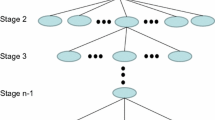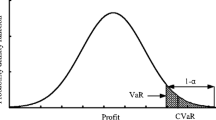Abstract
A conditional value-at-risk (CVaR) based inexact two-stage stochastic programming (CITSP) model was developed in this study for supporting water resources allocation problems under uncertainty. A CITSP model was formulated through incorporating a CVaR constraint into an inexact two-stage stochastic programming (ITSP) framework, and could be used to deal with uncertainties expressed as not only probability distributions but also discrete intervals. The measure of risks about the second-stage penalty cost was incorporated into the model, such that the trade-off between system economy and extreme expected loss could be analyzed. The developed model was applied to a water resources allocation problem involving a reservoir and three competing water users. The results indicated that the CITSP model performed better than the ITSP model in its capability of reflecting the economic loss from extreme events. Also, it could generate interval solutions within which the decision alternatives could be selected from a flexible decision space. Overall, the CITSP model was useful for reflecting the decision maker’s attitude toward risk aversion and could help seek cost-effective water resources management strategies under complex uncertainties.
Similar content being viewed by others
References
Andersson F, Mausser H, Rosen D, Uryasev S (2001) Credit risk optimization with conditional value-at-risk criterion. Math Program 89(2):273–291
Carneiro MC, Ribas GP, Hamacher S (2010) Risk management in the oil supply chain: a CVaR approach. Ind Eng Chem Res 49(7):3286–3294
Chang NB, Wen CG, Chen YL, Yong YC (1996) A grey fuzzy multiobjective programming approach for the optimal planning of a reservoir watershed, part A: theoretical development. Water Res 30(10):2329–2340
Dai L, Chen CH, Birge JR (2000) Convergence properties of two-stage stochastic programming. J Optim Theory Appl 106(3):489–509
Eiger G, Shamir U (1991) Optimal operation of reservoirs by stochastic programming. Eng Optim 17(4):293–312
Guo P, Huang GH, He L (2008) ISMISIP: an inexact stochastic mixed integer linear semi-infinite programming approach for solid waste management and planning under uncertainty. Stoch Environ Res Risk Assess 22(6):759–775
Huang GH (1996) IPWM: an interval-parameter water quality management model. Eng Optim 26(2):79–103
Huang GH, Loucks DP (2000) An inexact two-stage stochastic programming model for water resources management under uncertainty. Civ Eng Environ Syst 17(2):95–118
Huang GH, Baetz BW, Patry GG (1993) A grey fuzzy linear programming approach for municipal solid waste management planning under uncertainty. Civ Eng Environ Syst 10(2):123–146
Kall P (1979) Computational methods for solving two-stage stochastic linear programming problems. Z Angew Math Phys 30(2):261–271
Kira D, Kusy M, Rakita I (1997) A stochastic linear programming approach to hierarchical production planning. J Oper Res Soc 48(2):207–211
Li YP, Huang GH (2007) Inexact multistage stochastic quadratic programming method for planning water resources systems under uncertainty. Environ Eng Sci 24(10):1361–1377
Li YP, Huang GH, Nie SL, Mo DW (2008) Interval-parameter robust quadratic programming for water quality management under uncertainty. Eng Optim 40(7):613–635
Maqsood I, Huang GH, Yeomans JS (2005) An interval-parameter fuzzy two-stage stochastic program for water resources management under uncertainty. Eur J Oper Res 167(1):208–225
Piantadosi J, Metcalfe AV, Howlett PG (2008) Stochastic dynamic programming (SDP) with a conditional value-at-risk (CVaR) criterion for management of storm-water. J Hydrol 348(3–4):320–329
Qin XS, Huang GH, Zeng GM, Chakma A, Huang YF (2007) An interval-parameter fuzzy nonlinear optimization model for stream water quality management under uncertainty. Eur J Oper Res 180(3):1331–1357
Qin XS, Huang GH, Liu L (2010) A genetic-algorithm-aided chance-constrained programming model for regional air quality management under uncertainty. J Air Waste Manage Assoc 60(1):63–71
Rockafellar RT, Uryasev S (2000) Optimization of conditional value-at-risk. J Risk 2(3):21–41
Rockafellar RT, Uryasev S (2002) Conditional value-at-risk for general loss distributions. J Bank Finance 26(7):1443–1471
Roy B (1991) The outranking approach and the foundations of ELECTRE methods. Theory Decis 31(1):49–73
Russell SO, Campbell PF (1996) Reservoir operating rules with fuzzy programming. J Water Resour Plann Manage 122(3):165–170
Wagner JM, Shamir U, Marks DH (1994) Containing groundwater contamination: planning models using stochastic programming with recourse. Eur J Oper Res 77(1):1–26
Wang LZ, Fang L, Hipel KW (2003) Water resources allocation: a cooperative game theoretic approach. J Environ Inform 2(2):11–22
Webby RB, Adamson PT, Boland J (2007) The Mekong—applications of value at risk (VaR) and conditional value at risk (CVaR) simulation to the benefits, costs and consequences of water resources development in a large river basin. Ecol Modell 201(1):89–96
Xu Y, Qin XS (2010) Rural effluent control under uncertainty: an inexact double-sided fuzzy chance-constrained model. Adv Water Resour 33(9):997–1014
Xu Y, Huang GH, Qin XS (2009) Inexact two-stage stochastic robust optimization model for water resources management under uncertainty. Environ Eng Sci 26(12):1765–1776
Yamout GM, Hatfield K, Romeijn HE (2007) Comparison of new conditional value-at-risk-based management models for optimal allocation of uncertain water supplies. Water Resour Res 43(7):W07430
Author information
Authors and Affiliations
Corresponding author
Rights and permissions
About this article
Cite this article
Shao, L.G., Qin, X.S. & Xu, Y. A Conditional Value-at-Risk Based Inexact Water Allocation Model. Water Resour Manage 25, 2125–2145 (2011). https://doi.org/10.1007/s11269-011-9799-9
Received:
Accepted:
Published:
Issue Date:
DOI: https://doi.org/10.1007/s11269-011-9799-9




